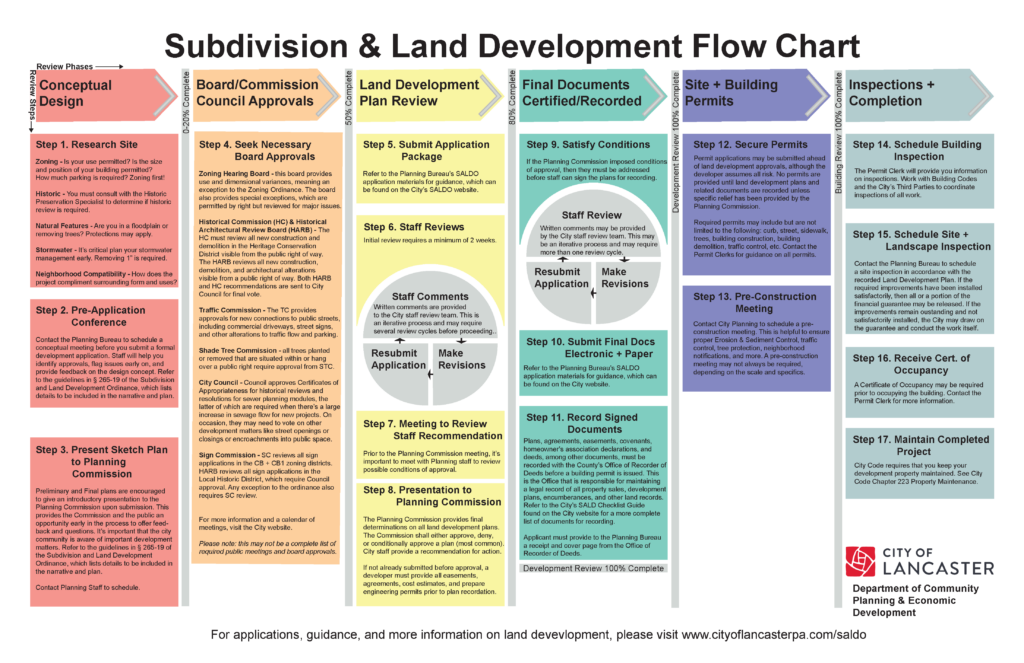Subdivision & Land Development (SALDO)
The Subdivision and Land Development Ordinances (SALDOs) are the most commonly used development control mechanism in Pennsylvania. The City’s SALDO establishes rules, regulations and standards for the subdivision and development of land, which is regulated by Chapter §265 of the City Code. These regulations may differ between municipalities.
PLEASE NOTE: THE SALDO WAS AMENDED ON NOVEMBER 10, 2020, AND THE ORDINANCE FOR AMENDMENT CAN BE VIEWED HERE.
All subdivision and land development activities require review by the Planning Bureau. An applicant shall submit a Subdivision & Land Development Plan Application with the appropriate fees and the necessary documents as described in the Subdivision & Land Development Checklists. All Final Plans are required to complete a Community Benefits Survey. All necessary forms and documents can be found below under the Documents & Resources tab.

Subdivision is the division or redivision of a single lot, tract or parcel of land by any means into two or more lots, tracts or parcels (including changes in existing lot lines) for the purpose, whether immediate or future, of lease or transfer of ownership.
Land development shall include the improvement of one lot or two or more contiguous lots, tracts or parcels of land for any purpose involving:
– A group of two or more residential or nonresidential buildings, whether proposed initially or cumulatively, or a single nonresidential building on a lot or lots, regardless of the number of occupants or tenure;
– The division or allocation of land or space, whether initially or cumulatively, between or among two or more existing or prospective occupants or landowners by means of or for the purpose of streets, common areas, leaseholds, condominiums, building groups or other features; or
– A subdivision of land.
The following development shall be excluded from the definition of land development:
– The conversion of an existing building into not more than three residential units, unless such units are intended to be a condominium.
– The conversion of an entire lot, parcel or tract of real estate into condominiums shall not, in and of itself, constitute a subdivision or land development for purposes of this chapter where the conversion involves no land development activities, including no division or allocation of land or space or change in lot lines, but simply memorializes a change in the form of ownership. This exclusion is adopted pursuant to 68 Pa.C.S.A. § 3106 of the Pennsylvania Uniform Condominium Act, 68 Pa.C.S.A. § 3101 et seq.
– The addition or conversion of buildings or rides within the confines of an enterprise which would be considered an amusement park.
– The combining of two or more adjacent lots or tracts of land under the same ownership.
The major purposes of subdivision and land development regulations are to provide adequate sites for development and public use, to maintain reasonable and acceptable design standards, and to coordinate public improvements with private development interests. More specifically, subdivision and land development regulations help achieve several objectives:
– They help contain municipal costs by having developers pay for public improvements necessitated by the development, and by requiring development design that is efficiently supported by municipal services.
– They protect the municipality from problems and costs it may have to inherit later from unplanned and poorly designed development.
– They ensure a decent quality of life for citizens by promoting healthy walkability, preventing stormwater damage, protecting natural resources, ensuring accessibility for fire and police services, among other things.
– They help a municipality attract investment in homes and businesses which are more these days seeking out great places with a quality built and natural environment.
A subdivision and land development ordinance differs from a zoning ordinance. A subdivision and land development ordinance does not control use of land or buildings. It does not define zones or districts in the municipality in which certain uses are permitted and others not, and in which there are different standards for density or intensity of development. A subdivision and land development ordinance’s design standards apply uniformly throughout a municipality.
